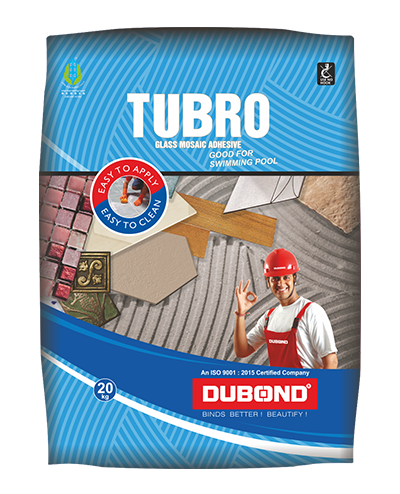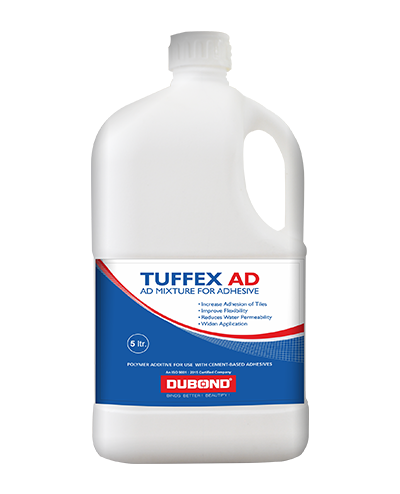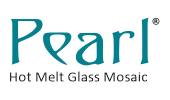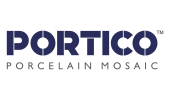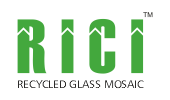CEMENTITIOUS ADHESIVE FOR ANY KIND OF TILE & STONE Designed especially for interior floor and wall installations and external floor installations of all types of ceramic tile, vitrified tile, precast terrazzo and natural stones over concrete and on a variety of cement based substrates. Pure Plus can also give very good adhesion for fixing granite on window seal, Can be used up to a maximum 12mm bed thickness
PURE PLUS
- Single component, just add water
- Interior applications, polymer based
- Economical & Easy to use
- Bonds to various substrates
- Exceeds ANSI A118.1 T shear bond strength requirements
- Complies with EN / ISO with a C1T classification.
- Exceeds IS 15477:2019 – Type 2 T Adhesive standards.
- Can be fortified with latex admix for use on external Wall area.
- Concrete
- Concrete Masonry
- Cement Mortar Beds
- Cement Plaster
- Existing Vitrified Tile & Ceramic Tile
- Brick Masonry
- Cement Terrazzo
- Existing Natural Stone
- Surface to be cleaned and roughened before installation of tiles or stones.
- Fixing absorent floor and wall tiles out doors and in doors.
- Fixing on heating floors.
- Fixing poorly absorbent materials or non-absorbent materials such as single-fired tiles, refine porcelain stoneware and vitrified tiles.
- Suitable for use when high performances are required, such as tile fixing in industrial environment or fixing on top of old ceramic tiles or natural stone indoors, in swimmingpools or on facades.
- The tiles can be made of cotto, double fired, single fired ceramic.
Special applications :
Replacement of mixing water with Tuffex AD, the professional elastomer latex, provides the adhesive with greater capacity of transversal deformation and greater resistance to water and tensile stress without modifying the open time and adjustment interval.
Peak with addition of tuffex AD exceeds the level of performance required by EN 12004 class C2 E. Please consult the Dubond Products (India) Pvt Ltd site to define use of this product for particular purposes such as:
- laying on deformable flooring and walls in plasterboard,
- laying on heat-radiant slabs,
- laying of large-format paving slabs in outdoor applications and in permanently humid environments,
- direct bonding on substrates in smoothed concrete with reduced water absorption.
All surfaces should be between 40° F(4°C) and 104° F(40°C) and structurally sound, clean and free of all dirt, oil, grease, loose peeling paint, laitance, concrete sealers or curing compounds.Check the surface to be true to plumb. All slabs must be plumb and true to within ¼”(6mm) in 10 ft(3m). Rough or uneven concrete surfaces should be made smooth with
Dubond Screed/Plaster material to provide a wood float (or better) finish. Dry, dusty concrete slabs or masonry should be dampened, and excess water swept off. Installation may be made on a damp surface.
New concrete slabs shall be damp cured and 28* days old before application.
*No minimum cure time for concrete slabs when thin-set mortar is mixed with latex additive.
Please refer specific product Technical Data Sheet for detailed recommendations.
Mixing:
- Place clean, potable water into a clean mixing bowl. Add Pure Plus powder into the mixing bowl.
- Use approximately 5.5 - 6L of water for 20 kg of powder. Mix by hand or with a slow speed mixer to a smooth, trowelable consistency.
- Allow adhesive to slake for 5 minutes.
- Adjust consistency if necessary. Remix and apply with the proper sized notched trowel.
- Apply adhesive to the substrate with the flat side of the trowel, pressing firmly to work into surface.
- Comb on additional adhesive with the notched side. Use the proper sized notched trowel to ensure full bedding of the tile.
- Spread as much adhesive as can be covered with tile in 10 minutes. Back butter large format tiles (> 12”x12”) to provide full bedding and firm support.
- Place tiles into wet, sticky adhesive and beat in using a beating block and rubber mallet to imbed tile and adjust level.
- Check adhesive for complete coverage by periodically removing a tile and inspecting bedding adhesive transfer onto back of tile.
- Use of spacers is recommended to provide grout joints between tiles / stones.
- The joint width shall be as per the recommendation of architect / engineer. Remove the spacers when the adhesive is set firm.
- If adhesive is skinned over (not sticky), remove and replace with fresh adhesive.
- For highly absorbent natural stones which may form a wet patch when adhesive is used, it is recommended to suitable Impregnating sealers on all sides.
Please refer Technical Data Sheets of product intended for use for specific instructions of use
NOTE TO THE SPECIFIER AND INSTALLER:
While installing tile/stone on the external floors, we need to provide the joints by creating spaces between the tiles/stones and fill them up with flexible grout. (In the absence of spacer joints, the surface movements can push tiles/stones away from the substrate causing debonding of tiles or stones)
The exterior tile / stone installations are provided with joints (spaces) on the periphery of the area without allowing the tile / stone to be bound by the peripheral masonry work or plaster.
HOT & COLD WEATHER TILING:
* Please refer technical document on Hot & Cold weather tiling
20 Kg bag.
12 Months with original packing in dry storage condition.
Approximately 55 to 60 sqft for 20 kgs bag with 6mm x 6mm square notch trowel for a bed of 3 mm
|
ANSI Data |
||
|
Property : Test method |
Requirement |
Typical Values |
|
Open Time(20 Minutes at 28 days): ANSI A118.1 Clause – 5.3 |
≥ 75 psi (0.50 Mpa) |
100 psi – 120 psi (0.68 – 0.82 Mpa) |
|
Sag:ANSI A118.1- Clause 6.0 |
≤ 0.02 Inches (0.50 mm) |
0.012 – 0.016 Inches (0.30-0.40 mm) |
|
Glazed wall tile Shear Strength |
||
|
7 Days: ANSI A118.1 – Clause 7.1.2 |
>200psi (1.38Mpa) |
225-275 psi (1.54 Mpa-1.89 Mpa) |
|
7 Days Water immersion: ANSI A118.1- Clause 7.1.3) |
>150psi (1.03Mpa) |
200-250 psi (1.37 Mpa-1.72 Mpa) |
|
Porcelain Mosaic Tile Shear Strength |
||
|
1 Day: ANSI A118.1 – Clause 7.2.2 |
>50psi (0.34Mpa) |
100 - 150 psi (0.68 – 1.03 Mpa) |
|
7 Days: ANSI A118.1 – Clause 7.2.3 |
>150psi |
200 - 250 psi (1.37 – 1.72 Mpa) |
|
7 Days Water immersion: ANSI A118.1 – Clause 7.2.4 |
>100psi (0.69Mpa) |
150 - 200 psi (1.03 – 1.37 Mpa) |
|
28 Days: ANSI A118.1 – Clause 7.2.5 |
>150psi (1.03Mpa) |
200 - 250 psi (1.37 – 1.72 Mpa) |
|
12 Weeks: ANSI A118.1 – Clause 7.2.6 |
>150psi (1.03Mpa) |
200 - 250 psi (1.37 – 1.72 Mpa) |
|
The adhesive mortar conforms to ANSI A118.1T |
||
|
EN / ISO Data |
||
|
Property: Test Method |
Requirement |
Typical Values |
|
Open Time: EN 1346 |
≥ 0.50 N/mm² |
0.65 – 0.75 N/mm² |
|
Slip Resistance: EN 1308 |
≤ 0.50 mm |
0.30 - 0.40 mm |
|
Tensile Adhesion Strength |
||
|
Initial: EN 1348 – Clause 8.2 |
≥ 0.50 N/mm² |
0.75 – 1.00 N/mm² |
|
After Water Immersion : EN 1348 - Clause 8.3 |
≥ 0.50 N/mm² |
0.75 – 1.00 N/mm² |
|
Heat Ageing: EN 1348 – Clause 8.4 |
≥ 0.50 N/mm² |
0.75 – 1.00 N/mm² |
|
Freeze- Thaw: EN 1348 – Clause 8.5 |
≥ 0.50 N/mm² |
0.75 – 1.00 N/mm² |
The adhesive mortar conforms to EN12004 / ISO 13007 as C1T
|
IS Data |
||
|
Property : Test method |
Requirement |
Typical Values |
|
Tensile Adhesion |
||
|
Dry Conditions – AnnexA (Clause 5.1) |
Minimum 1.00 N/mm ² |
1.15-1.25 N/mm² |
|
Wet Conditions – AnnexA (Clause 5.1) |
Minimum 1.00 N/mm ² |
1.15-1.25 N/mm² |
Shear Adhesion
|
Dry Conditions- (Annex B (Clause 5.2) |
Minimum 1.25 N/mm ² |
1.35-1.45 N/mm² |
|
Heat Ageing - Annex B (Clause 5.2) |
Minimum 1.00 N/mm ² |
1.05-1.15 N/mm² |
|
Wet ConditionsAnnex B (Clause 5.2) |
Minimum 1.00 N/mm ² |
1.10-1.20 N/mm² |
|
Slip resistance - Annex E (Clause |
≤ 0.5 mm |
0.35-0.45 mm |
The Adhesive conforms to IS 15477: Type 2T
Working Properties at 70° F (21° C)
Pure Plus Adhesive mixed with Water
|
Open Time |
20 minutes |
|
Pot Life |
3 - 4 hours |
|
Adjustment Time |
20 Minutes |
|
Time to Heavy Traffic |
16 - 24 hours |
Do not use on substrates with a gypsum and anhydrite base without use of HydroPrime the professional, concentrated, water-base, surface insulation product
1. Heat-radiant slabs,
2. High-flexibility substrates;
3. Marble floor tiles and natural stone,
4. Metal and wood;
5. On old ceramic flooring,
6. On plasterboard;
7. On plastic or resilient materials,
8. On substrates which are wet, subject to moisture rising or in continuous contact with water.
Do not use the adhesive to correct substrate irregularities greater than 10mm
Use Gloves. Non Toxic

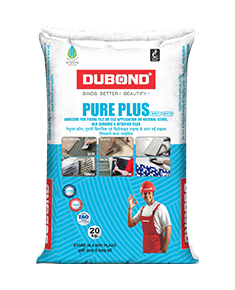
 Features & Benefits
Features & Benefits Area Of Application
Area Of Application Application
Application Packaging
Packaging Shelf Life
Shelf Life Coverage
Coverage Technical Data
Technical Data Safety Precautions
Safety Precautions Health & Safety Information
Health & Safety Information





